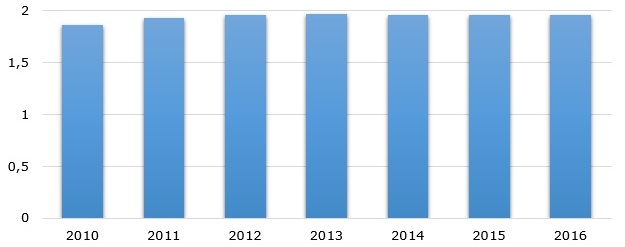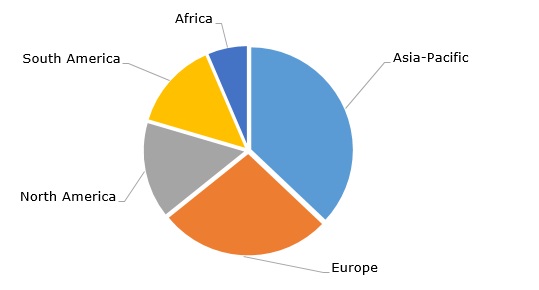Beer Market Performance and Trends in 2018
16 Mar 2018 • by Natalie Aster

LONDON – One of the oldest brewed alcoholic beverages, today beer is still among the most highly consumed alcoholic beverages enjoying strong demand from pole to pole.
Presently, no nation can outpace the Czechs in terms of the beer consumption volume. The Czech Republic has topped the beer drinking ranking for over 20 past years. In the year 2017, the per capita beer consumption in the Czech Republic slightly exceeded 137 liters. Poland, the second leading beer-consuming country, saw the per capita beer consumption of around 96 liters in 2017. In short, the list of top beer-drinking nations is topped by Eastern European countries.
Top 10 Beer-Consuming Countries, 2017 (beer sales per capita in liters).jpg)
Meantime, the beer sales revenue ranking (in per capita terms) looks completely different. The highest spending on beer is registered in Australia. In 2017, the average Australian spent appr. USD 452 on beer, while in Ireland, the second-placed country, an average spending on beer per capita was almost USD 347.6.
Countries with the highest spending on beer, 2017 (beer sales revenue per capita, in USD).jpg)
Beer Market Trends to Watch in 2018:
- Women to Drive Demand for Light Beer
Although strong beer accounts for almost 60% of the overall demand for beer, the one for light beer is predicted to demonstrate the highest growth. The expanding female consumer base (especially 21-30 years old) owing to low alcohol and calorie content of the light type of beer is the major contributor to this growth.
- Microbreweries to Be on the Rise
Due to ease of setup, microbreweries are to see a remarkable upswing in the offing. Growth in the major craft beer market, the US, is gradually slowing: though the popularity of craft beer is still in the country, the increasing number of microbreweries may cause a disbalance of the supply-demand equilibrium in the short-term. However, the craft beer market is still in its infant stage across many developing countries that present enormous growth potential. Therefore, microbrewery openings are anticipated to expand geographically.
- Demand for Premium Beer to Increase
Value is the main growth driver of the beer market given the shifting interest towards higher-quality and higher-priced products. Besides, consumers are increasingly giving preference to locally produced super premium and premium international beer varieties. In fact, the premium beer category is projected to pick up at a CAGR of nearly 6.5% in the years ahead.
- Competition between Canned and Bottled Beer to Remain Fierce
Globally, the demand for canned beer is higher than for other packaging options. Meantime, sales of ales and flavored beer drinks in bottles are skyrocketing, and the demand for bottled beer is also swelling. Therefore, fierce competition between canned and bottled beer will continue.
- Non/Low-Alcoholic Beer to Pique Consumers’ Interest
Nowadays, non/low-alcoholic beer draws much attention, particularly among top international brewers. This category outperforms the total beer sector’s growth pace across many mature markets, especially in the Western European region. Moreover, the demand for non/low-alcoholic beer is also fueled by enhancing health concerns among consumers. Still, this category holds a minimal share of the overall beer market volume.
World’s Beer Market to Demonstrate One-Digit Growth through 2020
The value of the global market for beer reached the USD 530 billion mark in 2016. It is forecast to continue rising up at a CAGR of nearly 6% and will likely climb to USD 750 billion by the year 2022.
Various factors act as engines of the beer market growth, including increasing disposable incomes globally, changing lifestyles, and escalating local breweries number. Besides, the elevating demand for beer across emerging markets, especially in the APAC region, will create novel growth avenues for the beer market. However, some factors like changes in legal regulations, associated health issues, and heavy taxation may hamper further market growth.
As for the global production of beer, it considerably slowed down over the recent years and remained at approximately the same level during 2012-2017.
Global beer production during 2010-2016 (in billion hectoliters)
At present, APAC dominates the world’s beer market, grabbing a share of almost 37% of the overall market volume. Also, it accounts for the biggest revenue share. Besides, this regional market demonstrates the highest growth rates, driven primarily by the huge population, a high number of youngsters, expanding middle-class, and also rising disposable incomes of the local consumers. The APAC beer market is projected to maintain the highest growth pace in the next years.
Europe and North America rank second and third in the worldwide beer market, respectively. However, North America was the only regional market that exhibited a decline in the overall beer consumption over the last few years. Both the European and North American markets are slated to experience moderate growth in the short-term owing to enhancing health concerns and the introduction of new legal regulations.
Meantime, the beer market in South America and Africa demonstrated considerable upturn in consumption volume during 2016-2017. These regional markets are poised for a substantial upturn in the short to medium term.
Structure of the world’s beer market by regions

As for beer-producing countries, China is an unrivalled leader. In 2016, China’s beer production was around 460 million hectoliters. A second leader, the US, produced slightly over 221,3 million hectoliters in the same year. Meantime, the beer production in Brazil, one more prominent producer, stood at appr. 133.3 million hectoliters.
Leading beer-producing countries, 2016 (in million hectoliters)
.jpg)
Conclusion
On the back of the moderating growth in the world’s beer market, traditional brewers are likely to get under the pressure to introduce new products. Consumers are sick of drinking the same beer and more often give preference to craft, artisanal and other premium beers. Although the world’s beer market is poised for a single-digit increase in the foreseeable future, there is still great potential for the specialty and premium beer categories to scale up their market shares via product innovation and win back beer drinkers who have shifted to other alcoholic beverages.
© MarketPublishers.com, 2018
Analytics & News
